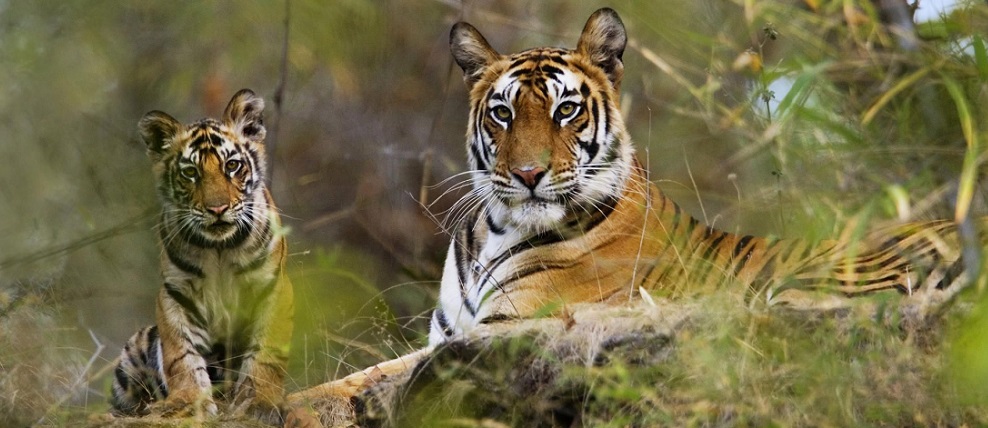Nestled in the heart of Madhya Pradesh, India, Bandhavgarh National Park is a sanctuary of natural beauty and biodiversity. Spanning an area of 450 square kilometers, this park is renowned for its high density of Bengal tigers, making it a premier destination for wildlife enthusiasts and photographers.
History and Significance of Bandhavgarh Tiger Reserve
Bandhavgarh has a rich historical tapestry interwoven with mythological and archaeological significance. The park is named after the Bandhavgarh Fort, an ancient structure believed to have been gifted by Lord Rama to his brother Lakshmana. This fort, perched atop the Bandhavgarh Hill, offers panoramic views of the surrounding forest and is a testament to the area's historical importance. The fort itself is surrounded by numerous caves with inscriptions and ancient carvings, adding to the mystique of the region.
Flora and Fauna of Bandhavgarh National Park
The park's diverse topography, ranging from steep ridges to undulating forests and open meadows, supports a variety of flora and fauna. Bandhavgarh is home to around 22 species of mammals and 250 species of birds. The park's vegetation primarily consists of moist deciduous forests with sal and bamboo trees dominating the landscape. Grassy meadows, which were once agricultural fields, are now prime grazing grounds for herbivores.
Bandhavgarh's star attraction is undoubtedly the Bengal tiger. The park boasts one of the highest tiger densities in India, offering visitors a relatively higher chance of spotting these majestic cats. Alongside tigers, the park is also home to leopards, sloth bears, Indian gaur, sambar, barking deer, and a variety of bird species such as the crested serpent eagle, Indian roller, and stork.
Safari Zones of the Bandhavgarh Park
Bandhavgarh is divided into several zones, with Tala, Magadhi, and Khitauli being the most popular among tourists. Each zone offers a unique landscape and a different set of wildlife experiences. The Tala zone of Bandhavgarh, often considered the park's heart is famous for tiger sightings and its picturesque terrain. The Magadhi zone, known for its meadows and dense forests, and the Khitauli zone, with its diverse birdlife and herbivore sightings, complement the Tala zone to provide a comprehensive wildlife experience.
Bandhavgarh National Park plays a critical role in India's tiger conservation efforts. The park's administration has implemented several measures to protect its wildlife and habitat. Anti-poaching units, regular patrolling, and community involvement are some of the strategies employed to safeguard the park's inhabitants. The relocation of villages from the core area has also been a significant step towards minimizing human-wildlife conflict and allowing the ecosystem to thrive.
Visitor Experience in Bandhavgarh
Bandhavgarh offers an immersive wildlife experience with its jeep and elephant safaris, guided by experienced naturalists. The best time to visit the park is between October and June, with the peak tourist season being from March to May when tiger sightings are more frequent due to the dry weather.
Accommodation options range from luxury resorts to budget-friendly lodges, ensuring a comfortable stay for all types of travellers. Many of these establishments provide eco-friendly amenities and are involved in conservation awareness programs.
Despite its successes, Bandhavgarh faces several challenges, including habitat fragmentation, human encroachment, and the pressures of tourism. Continuous efforts are needed to balance wildlife conservation with sustainable tourism. The involvement of local communities in conservation initiatives is crucial for the park's long-term sustainability.
Looking forward, Bandhavgarh National Park aims to strengthen its conservation strategies, enhance eco-tourism practices, and foster a harmonious relationship between humans and wildlife. With its rich biodiversity and cultural heritage, Bandhavgarh remains a vital bastion of India's natural legacy and a beacon for wildlife conservation.
Bandhavgarh National Park is not just a haven for wildlife but also a living museum of natural history and culture. Its lush landscapes, diverse species, and ongoing conservation efforts make it a must-visit destination for anyone passionate about nature and wildlife. As we look to the future, it is imperative to support and preserve such treasures, ensuring that the roar of the tiger continues to echo through Bandhavgarh forests for generations to come.

